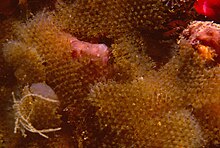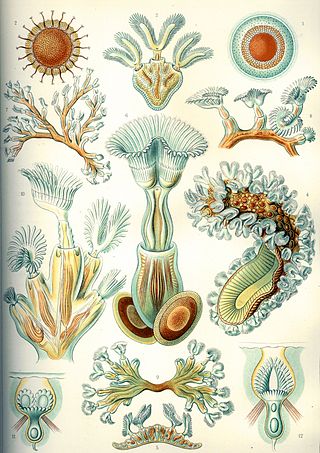
Bryozoa are a phylum of simple, aquatic invertebrate animals, nearly all living in sedentary colonies. Typically about 0.5 millimetres long, they have a special feeding structure called a lophophore, a "crown" of tentacles used for filter feeding. Most marine bryozoans live in tropical waters, but a few are found in oceanic trenches and polar waters. The bryozoans are classified as the marine bryozoans (Stenolaemata), freshwater bryozoans (Phylactolaemata), and mostly-marine bryozoans (Gymnolaemata), a few members of which prefer brackish water. 5,869 living species are known. Originally all of the crown group Bryozoa were colonial, but as an adaptation to a mesopsammal life or to deep-sea habitats, secondarily solitary forms have since evolved. Solitary species has been described in four genera; Aethozooides, Aethozoon, Franzenella and Monobryozoon). The latter having a statocyst-like organ with a supposed excretory function.

Cheilostomatida, also called Cheilostomata, is an order of Bryozoa in the class Gymnolaemata.

Membranipora membranacea is a very widely distributed species of marine bryozoan known from the Atlantic and Pacific Oceans, usually in temperate zone environments. This bryozoan is a colonial organism characterized by a thin, mat-like encrustation, white to gray in color. It may be known colloquially as the coffin box, sea-mat or lacy crust bryozoan and is often abundantly found encrusting seaweeds, particularly kelps.

Cyclostomatida, or cyclostomata, are an ancient order of stenolaemate bryozoans which first appeared in the Lower Ordovician. It consists of 7+ suborders, 59+ families, 373+ genera, and 666+ species. The cyclostome bryozoans were dominant in the Mesozoic; since that era, they have decreased. Currently, cyclostomes seldom constitute more than 20% of the species recorded in regional bryozoan faunas.
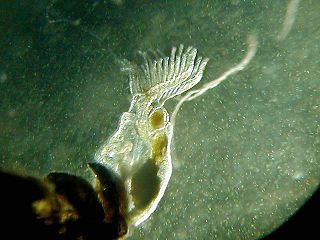
Phylactolaemata is a class of the phylum Bryozoa whose members live only in freshwater environments. Like all bryozoans, they filter feed by means of an extensible "crown" of ciliated tentacles called a lophophore, and like nearly all bryozoans, they live in colonies, each of which consists of clones of the founding member. Unlike those of some marine bryozoans, phylactolaemate colonies consist of only one type of zooid, the feeding forms known as autozooids. These are supported by an unmineralized "exoskeleton" made of gelatinous material or protein, secreted by the zooids. The class contains only one extant order, Plumatellida.
Perophora viridis, the honeysuckle tunicate, is a species of colonial sea squirt in the genus Perophora found in the tropical western Atlantic Ocean.
Amathia vidovici is a species of colonial bryozoans with a tree-like structure. It is found in shallow waters over a wide geographical range, being found in both the Atlantic and Pacific Oceans and adjoining seas.
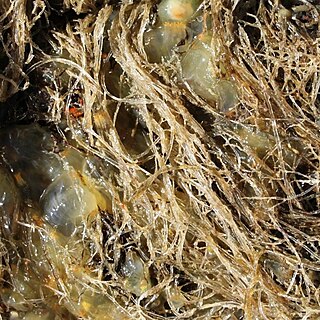
Amathia verticillata, commonly known as the spaghetti bryozoan, is a species of colonial bryozoans with a bush-like structure. It is found in shallow temperate and warm waters in the western Atlantic Ocean and the Caribbean Sea and has spread worldwide as a fouling organism. It is regarded as an invasive species in some countries.

Conopeum seurati is a species of colonial bryozoan in the order Cheilostomatida. It is native to the northeastern Atlantic Ocean, the North Sea and the Mediterranean Sea. This species has been introduced to New Zealand and Florida.

Electra pilosa is a species of colonial bryozoan in the order Cheilostomatida. It is native to the northeastern and northwestern Atlantic Ocean and is also present in Australia and New Zealand.

Bugula neritina is a cryptic species complex of sessile marine animal in the genus Bugula. It has a practically cosmopolitan distribution, being found in temperate and tropical waters around the world, and it has become an invasive species in numerous locations. It is often found in hard substrates, such as rocks, shells, pillars and ship hulls, where it can form dense mats, contributing to biofouling. B. neritina is of biomedical interest because it harbors a bacterial symbiont that produces a group of bioactive compounds with potential applications in the treatment of numerous diseases.

Cryptosula pallasiana is a species of colonial bryozoan in the order Cheilostomatida. It is native to the Atlantic Ocean where it occurs in northwestern Europe and northern Africa, and the eastern seaboard of North America. It has been accidentally introduced to the western coast of North America and to other parts of the world.

Watersipora subtorquata, commonly known as the red-rust bryozoan, is a species of colonial bryozoan in the family Watersiporidae. It is unclear from where it originated but it is now present in many warm-water coastal regions throughout the world, and has become invasive on the west coast of North America and in Australia and New Zealand.

Catenicella is a genus of marine bryozoans belonging to the family Catenicellidae. Bryozoans are colonial animals that live in aquatic environments, and Catenicella is no exception. Members of this genus are found in oceans around the world, with a particularly high diversity in the Arctic and Antarctic regions.

Electra posidoniae is a species of bryozoan in the family Electridae. It is endemic to the Mediterranean Sea, and is commonly known as the Neptune-grass bryozoan because it is exclusively found growing on seagrasses, usually on Neptune grass, but occasionally on eelgrass.
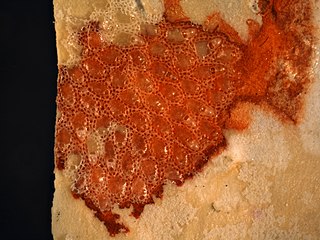
Chorizopora brongniartii is a species of bryozoan in the family Chorizoporidae. It is an encrusting bryozoan, the colonies forming spreading patches. It has a widespread distribution in tropical and temperate seas.
Bicellariella ciliata is a species of bryozoan belonging to the family Bugulidae. It is found in shallow water on both sides of the Atlantic Ocean, the Mediterranean Sea and the Indo-Pacific region.

Crisularia plumosa is a species of bryozoan belonging to the family Bugulidae, commonly known as the feather bryozoan. It is native to the Atlantic Ocean.
Walkeria tuberosa is a species of colonial bryozoan in the order Ctenostomatida. It is native to the Mediterranean Sea, and has spread to the Red Sea and the Indo-Pacific region.
Walkeria uva is a species of colonial bryozoan in the order Ctenostomatida. It occurs on either side of the Atlantic Ocean, in the Baltic Sea, in the Mediterranean Sea and in the Indo-Pacific region.
